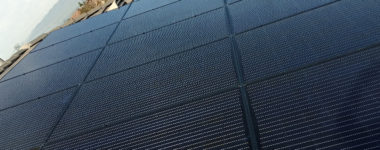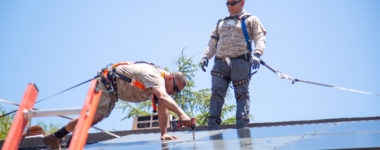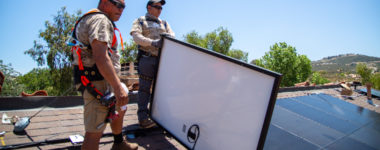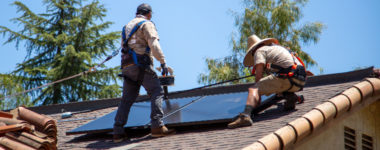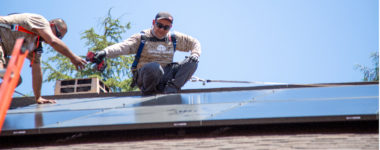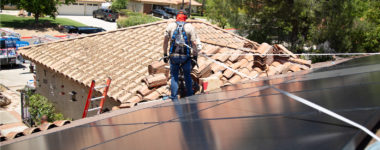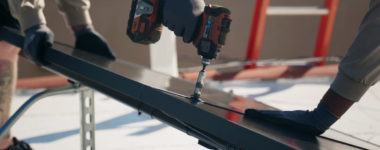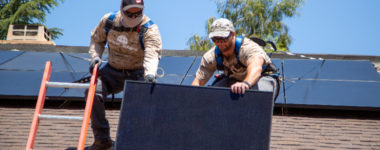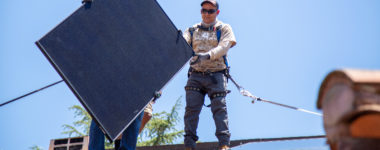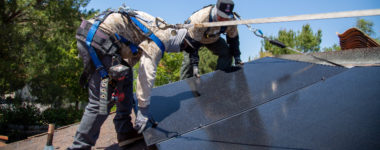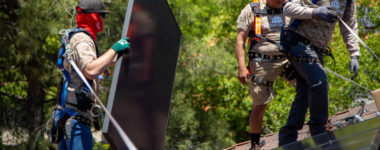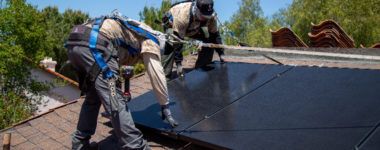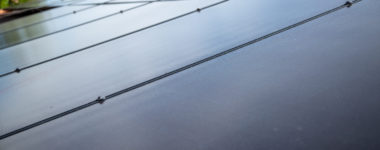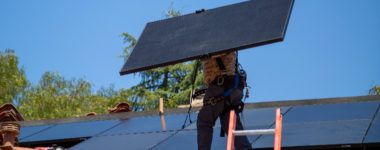Semper Solaris Blog
If you live in California and are wondering, “How can I find solar providers near me?” then you are in luck. You just happen to live in the number one solar state in the country, a state that employs over 80,000 people in the solar industry. If you live in or near a major city in California, chances are good that dozens of solar installation companies would love to have your business. The real trick, then, isn’t finding a solar installation company near you, it’s figuring out how to choose the best solar company to perform your installation. Putting a solar panel system on your roof is a major expense and represents a big renovation to your home. Workers will need to install racking to your roof and make changes to your electrical system. The solar installer you choose will be the key to ensuring that this process goes smoothly. The quality of their team will play a big role in how well your system functions after the installation and the overall solar power system cost. In other words, choosing a solar installer is a very important decision that shouldn’t be taken lightly. Rather than searching on Google for “solar providers near me,” and choosing the company that paid for an ad at the top of the search engine rankings, do your homework! Not sure how to start your search? Here are four easy steps to help you find the best solar installer in your area. Step One: Ask Your Neighbors and Friends for Referrals The best way to determine whether a solar installer is knowledgeable, trustworthy, and easy to work with is to ask people who have already used them. You won’t find true feedback on a company from the carefully chosen testimonials on their website. Instead, turn to your friends and family who have solar panels and ask about their experience. They will be more than happy to tell you the good, the bad, and the ugly about their solar journey and will also help you understand what to expect as you start on your own solar adventure. The main purpose of this step is to eliminate solar companies that didn’t provide excellent service for your friends, family, and neighbors. If you get a glowing recommendation about a particular solar company, resist the temptation to immediately contact them and sign a contract. Keep in mind that your friend or family member may have not done their homework and could have used the first company that came up in their Google search. You can’t know whether they truly got the best service and price. Keep their recommendations handy and then continue with your research. Step Two: Check Out Review Sites Your friends and neighbors should be able to give you a list of solar installation companies they used and liked (and a list of companies to steer clear of). Of course, you shouldn’t base such a big purchase decision on a single recommendation, so your next step is to do some more research on your new list of prospects. It’s time to head online and see what other previous customers say about your potential solar installers. (Note: If you recently moved to town or don’t have any friends or family who can make solar recommendations, just go straight to this step.) We recommend reading up on reviews at SolarReviews, Angie’s List, and the Better Business Bureau. Use Yelp as a last resort, as the reviews on that site aren’t always of the highest quality. The beauty of large review websites is that you’ll get to learn about the experiences of a number of different people, so you can get a much better idea of how a company consistently operates. It is important to keep in mind that many people are spurred to write reviews based on either a very good experience or a very bad experience, so what you read may not be a completely accurate reflection of a company. Don’t be afraid of one terrible review for a company if the majority of their reviews are positive. If you see a pattern of poor service, then it’s time to cross that name off your list! As you read through reviews, here are a few general things to look for: Did the solar installation company provide good communication throughout the process? Did the company stick with their timeline? Did the company stay on budget? Was the company able to address any concerns the customer had? Was the company able to pull permits, schedule inspections, and order the equipment in a timely manner? Did the installation face any problems? How did the company address these problems and was the customer satisfied with their solution? Is the solar panel system running and working well? Overall, how satisfied is the customer with their experience? It’s important to know that very few solar installations go off without a hitch. Equipment shipping from the manufacturer may be delayed. Perhaps an inspection of the roof revealed damage that required a repair. Maybe someone at the permitting office lost a permit request. These things happen. When you read reviews about a solar installation company, focus on how well they address the inevitable issues that occur. Step Three: Request a Consultation After reading reviews of your potential installers, it’s time to pick a few top contenders. Try to narrow your list to between two and four companies that have gotten an endorsement from a friend or family member and have generally positive reviews. It’s time to request a consultation. Any solar installation company worth their sunbeams should offer a free consultation. Give the company a call or fill out the form on their website, and you should be contacted shortly by a representative to schedule the consultation. The company will send an experienced associate to your home to discuss your project, goals, and budget. Here are a few of the things to expect during your consultation. The association will: Calculate your home’s average monthly energy usage Assess your roof to understand its orientation, slope, and pitch, which all affect how much direct sunlight it receives Determine if you would be a good candidate for a rooftop solar system and/or discuss alternative configurations, like ground mount systems or carport solar systems Discuss your budget and provide you with information about different payment options, including no-money offers, leasing, and power purchase agreements Review and recommend different solar panel brands and inverter brands to help you decide which equipment would work best with your budget and goals Discuss the benefits and drawbacks of hooking your system directly to the public utility grid to versus investing in a solar storage solution, like a Tesla Powerwall Walk you through the full installation process, including ordering the equipment, pulling permits, scheduling inspections, and hooking your system to the grid. Discuss all renewable energy incentives that you may qualify for, including the Investment Tax Credit Provide you with a recommended solar plan, which will include a timeline and price quote for the entire project The best associates will take the time to learn about your unique situation, answer your questions, and address your concerns. Ideally, they’ll also tell you about their company’s history and mission and help you feel comfortable with the entire solar installation process. Not every solar installer is the right choice for your project. Often, you’ll see red flags during the consultation, such as: The associate tries to steer you towards a specific payment plan The associate recommends a certain size solar system without explaining why that size is a good fit for your family The associate recommends a solar system that is bigger than you need The associate only offers you one or two solar panel brands to choose from and doesn’t really know much about how other brands compare The associate doesn’t know the answers to many of your questions and doesn’t offer to research them and follow up with you The associate doesn’t listen to you and rushes the consultation Once you’ve completed all the consultations, it’s time to compare your quotes and make the big decision. Step Four: Choosing a Solar Provider Near Me After your solar consultations are complete, you may have a clear winner in mind, or perhaps you were able to cross one or two companies off your list, leaving you with several great options to choose from. Now it’s time to compare your quotes and think carefully about how you feel about each company. While it’s tempting to simply choose the company that offers the lowest solar power system cost, we encourage you to take a number of factors into consideration, including: Your comfort level with the company The company’s communication Overall customer reviews The company’s willingness to provide a personalized solar recommendation plan for you One other important factor to contemplate is whether or not the company is locally established. By taking your business to a local solar company, you are keeping your dollars in your community and supporting local, high-paying solar jobs for your friends and neighbors. There’s another important reason to “go local.” A local solar installation company will already be familiar with common roofing trends in your neighborhood which can help them avoid issues when they begin their installation. Local companies are also highly experienced pulling permits in your area. They know where to go and how to fill out the forms. Finally, they are also much more likely to know if any local renewable energy incentives – like rebates or tax deductions – are available. At Semper Solaris, we believe in investing in local communities, which is why we have opened locations throughout California. We are a veteran owned and operated business that instills our military values of integrity, responsibility, and attention to detail into everything that we do. When it comes time to search for solar installers in your area, we encourage you to take a look at all of our reviews on SolarReviews.com, Angie’s List, and The Better Business Bureau. We would appreciate the opportunity to compete for your business. Schedule a solar consultation today.
In the 1940s and 1950s, the glamor of Los Angeles was dimmed by choking clouds of brown smog. Parents kept their children out of school, while rates of asthma and lung disease shot up. Los Angeles was among the dirtiest cities in the country. Today, things have changed dramatically. The city is pursuing an ambitious sustainability plan, which is powered in part by solar power in Los Angeles. In fact, the city that was once infamous for its noxious pollution was ranked the number one solar energy city in America by the California Research & Policy Center. How did the City of Angels manage such a miraculous turnaround, and what part did solar play in its lofty revitalization? Finally, how will major new environmental decisions within the city and the state of California affect Los Angeles residents in the future? Attack of the Smog It would have made for a good Hollywood horror flick – in the early 1940s, residents of Los Angeles noticed a foul-smelling, brown tinge to the air, which made their eyes water and their lungs burn. The effect was so dramatic that some residents believed it was a chemical attack from the Japanese as part of the ongoing war! Over the following decades, smog would regularly choke residents of Los Angeles, forcing children to stay home from school and canceling athletic events. Doctors noticed more and more patients reporting asthma and lung conditions, while lung autopsies on young car accident victims in 1987 revealed that over 25% had seriously damaged lungs! The citizens of Los Angeles demanded answers, and their protests helped lead to the first nascent environmental laws. In 1963, Congress enacted the first Clean Air Act, which was updated with stronger regulations in the 1970s. It wasn’t until 1975 when the United States required that all new cars include catalytic converters, that the problem of smog finally began to dissipate (though it is still a serious problem in major cities throughout the world, most notably in Beijing.) While the catalytic converters helped make driving a little less dirty, it didn’t change the fact that Los Angeles and the entire country was powered by dirty fossil fuels. The city and the country needed an alternative, but alternative energy technology was seriously limited. The Slow Evolution of Solar Panels Solar panels may seem like a relatively new technology, since they only started appearing en masse on rooftops over the past two decades. The truth, however, is that the technology was discovered over 150 years ago in 1839 by French physicist Alexandre Edmond Becquerellar. The first solar panels as most of us would recognize them were invented in Bell Labs in 1954, during some of the worst smog years in Los Angeles. At that time, however, solar panels were more of an amusing novelty. Boasting an anemic one percent efficiency, they could hardly keep a few lightbulbs shining, much less power entire homes! For several decades, the promise of solar power remained unrealized. Oil was cheap and climate change was a virtually unknown threat still on the horizon. It wasn’t until the oil embargos of the 1970s forced Americans to line up at gas pumps across the country that researchers, politicians, and everyday citizens recognized the value of developing alternative energy. This led to a rush of funding, research, and development into renewable energy. In 1978, the federal government passed the Public Utility Regulatory Policy Act and the Energy Tax Act, which laid the groundwork for net metering and offered tax credits to consumers who adopted solar panels. Spurred by all this interest and money, solar panel technology improved quickly, along with the manufacturing process. Together, these trends led to big increases in solar panel efficiency and significantly lower costs. Today, many of the top solar panel brands offer an efficiency of just over 20%. Prices for solar panel systems have also dropped around 60% over the last decade. These big changes have led to a steady increase in solar adoption across the entire country. But how did Los Angeles become the leader of the solar panel pack? It starts with that fact that Los Angeles is located in a state that embraces renewable energy. California – Land of the Solar Panels Los Angeles may produce the most solar power of any city in the country, but it is hardly an outlier in California. The Golden State has made a big bet on going green and put into place some of the most ambitious (and strictest) clean energy laws in the land. In 1996, Governor Pete Wilson deregulated the state’s investor-owned utilities and offered incentives for the public utilities to allow solar systems to connect to their grids. This paved the way for California’s incredibly powerful and successful net metering system, which makes solar power in Los Angeles so affordable. In 2015, Governor Jerry Brown set what seemed like an extremely ambitious goal by signing Senate Bill 350, which required the state to produce 33% of its energy from renewable sources by 2020 and 50% of its energy from renewable sources by 2030. In response, California rose to the challenge and surpassed its 2020 goal three years early! Perhaps it was these impressive results that convinced Governor Brown to cement his green energy legacy by signing Senate Bill 100 just this past month, which committed California to becoming 100% energy independent and carbon free by 2045. This commitment dramatically raises the bar for California and makes it only the second state in the union to commit to completely cutting their reliance on fossil fuels. How will California and Los Angeles achieve such a big goal? Solar will be a big part of the equation. In May of this year, California made big waves when the California Energy Commission voted unanimously to require all new homes and businesses to have solar power, starting in 2020. California’s aggressive environmental goals mean that every city within the state, especially its most populous, will need to make big changes. How is solar power in Los Angeles helping the state meet its carbon-free commitments? The Sun Is the Biggest Star in Hollywood Los Angeles is ready to lead the state of California and the country in adopting solar power. According to the report, “Shining Cities 2018: How Smart Local Policies Are Expanding Solar Power in America,” Los Angeles has installed 349.3 megawatts of solar power through the city. That’s enough energy to power 82,500 homes, take over 40,000 cars off the road, and eliminate 187,304 metric tons of greenhouse gas emissions. Tinsel Town is just getting started. The city recently unveiled a 2.21 MW(megawatt) solar installation on the Los Angeles Convention Center, which represents the largest solar system on a publicly-owned convention center on the entire west coast. Mayor Eric Garcetti has also unveiled an ambitious multi-pronged Sustainable City pLAn for Los Angeles that includes a focus on installing more solar power, improving air quality, managing the city’s water supply, investing in green jobs, and completing 28 major Metro projects by the 2028 Olympic and Paralympic games. As part of the Sustainable City pLAn, Los Angeles has already launched “Solar Rooftops,” a program that installs solar panels in communities with low solar penetration. The Sustainable City pLAn has also streamlined the online permitting process, making it faster and easier than ever for LA residents and businesses to go solar. With so much focus on solar installation in Los Angeles, what can residents expect for LA’s solar future? A City with a Bright Future As California begins to implement its goal to go carbon neutral by 2045, solar power will be a big part of that solution. In 2020, all new homes and businesses within Los Angeles will be required to have some solar capacity. That means that solar panels will become much more abundant throughout the city, even in low-income neighborhoods, thanks to Los Angeles’ “Solar Rooftops,” initiative. However, citizens may not notice as much of a visual change. That’s because Tesla is producing solar panel roof tiles that look just like ordinary roof tiles. (They currently offer four options: Tuscan, slate, textured, and smooth glass tiles.) Other companies are working to improve the appearance of solar panels by eliminating the frames or even making “solar skins” that help panels blend into a home’s existing roof. LA residents may also be able to enjoy a lot more bang for their solar panel buck. While today’s top panels offer just over 20% efficiency, researchers have been able to achieve 46% efficiency using advanced materials in a lab setting. It may be a while until a solar panel with that level of efficiency hits the consumer market, but we now know that it is possible. The near future may also crack one of the biggest challenges of using solar – the relative lack of storage potential. Solar panels have always been hamstrung by the fact that they only produce energy when the sun is out and shining. New battery technology, including Tesla Powerwall, are starting to change that dynamic and make it possible for homeowners and utilities to store excess solar power. Exciting announcements in this field may presage even more advancements in battery technology. One of those big technological leaps may be happening right here in Los Angeles. Dr. Patrick Soon-Shiong recently announced that his company, NantEnergy, based in Phoenix and El Segundo, has developed a battery that utilizes zinc and oxygen, which he claims is much more affordable, safe, and powerful than the lithium-ion batteries we use today to power electric cars and store solar power. Dr. Soon-Shiong, who also owns the Los Angeles Times and is a part owner of the LA Lakers, has already tested the zinc-oxygen batteries in several villages in Africa and Asia and cell phone towers in the United States. The next huge leap in solar technology could already be here, right in the heart of Los Angeles! Solar Power Is Home in Los Angeles Los Angeles has come a long, long way from a city choking on poisonous smog. Today, it is leading the charge to adopt clean energy, fight climate change, and protect the health of its citizens. As solar panel technology continues to improve, especially in the department of solar battery storage, Los Angeles could one day become a city that runs entirely on renewable energy in a state with a zero carbon footprint. It may seem like a wishful daydream, but Los Angeles is all about making dreams come true. We are glad to be a part of that dream. If you are interested in solar installation in Los Angeles, contact us today to schedule a free, no-pressure energy analysis.
Going Solar: It Has Never Been Easier Paying for your Solar Power System in Orange County California solar incentives and tax credits have put solar power within range for homeowners and businesses. With California’s new laws requiring solar on new construction, and the goal of phasing into renewable energy by 2045, the cost of solar installations are dropping in Orange County and all across the state and is significantly lower than the rest of the country. Homeowners are cashing in on low prices, rebates, and incentives and reducing their carbon footprint. Yorba Linda sees the lowest solar prices in the country. Bill, a Yorba Linda homeowner, recently installed his solar system using a PPA agreement. With fixed monthly payments on a 20-year contract, he was able to reduce his monthly bill considerably with a balanced billing plan, and receive credits for unused power at the end of the year. Bill is also passionate about saving the planet. Here are some ways you can finance your solar power: Net Metering Net Metering is an incentive system in which solar panel generators connect to a public-utility power grid. Meters measure the power generated and how much energy you use. The surplus power generated is transferred to the power grid. When your system produces more power than you use in a month, your utility provider credits your bill for the number of kilowatt-hours that went back to the grid. So you pay for the electricity you use, minus the excess electricity generated by your solar panels. Solar Loans If you want to buy your solar panels, a solar loan is a good option. These loans are similar to any other home improvement loans, and you can find them at banks or solar panel manufacturers. Plus, you can take advantage of the Federal Solar Tax Credit (ITC) and other tax deductions where applicable. Power Purchase Agreement (PPA) and Solar Leases A PPA or lease gives you all the benefits of using a solar panel system without purchasing it. The PPA provider installs solar panels on your property in exchange for paying them a reduced rate for solar the electricity for a set term, usually 20 years. There is a low or no upfront cost. The provider owns, controls and maintains the system, and receives the rebates and Federal Tax Credits for the installation. Property Assessed Clean Energy (PACE) You can finance your solar energy installation with a PACE program loan available to homeowners through an authorized PACE lender. PACE financing is affixed to the property and paid through the annual property tax bill. The tax rate determines the interest rate. If you sell your property before paying off the loan, the balance transfers to the new owner. Home Energy Renovation Opportunity (HERO) The HERO program is a residential Property Assessed Clean Energy (PACE) program for home renovation loans. HERO finances home improvements for solar as well as other energy efficiency residential projects. You can lower your home’s energy expenses as well as increase the value of your property while reducing your carbon footprint. Contact Semper Solaris for more information on financing and schedule an evaluation for your home or business.
ROOFTOPS OR SOLAR FARMS? Participating in the Future of Renewable Energy Solar power is on the rise and is fast becoming a mainstream energy alternative for homes, businesses, and public places. With lower costs and due to innovative and efficient designs, more people are getting on board as the price tag on solar installations is falling, becoming an opportunity for consumers and businesses to cash in. In Riverside County, UC Riverside has installed over 9,000 panels in a solar farm that will produce enough power for nearly 1,000 homes each year. Homeowners from nearby cities like Murietta are joining in the trend with rooftop solar installations. Murietta is among the towns that enjoy the lowest prices ever for rooftop solar installations. ACCESS TO SOLAR ENERGY Consumers are taking advantage of the benefits of solar energy through government incentives and tax credits for homes and businesses. Rooftop solar and solar farms provide a choice to consumers whether to install solar panels on their roofs or rely on solar farms to reduce their carbon footprint and save money. UP ON THE ROOF Photovoltaic panels made from silicon use the sun directly to generate power. These photovoltaic panels, installed on rooftops, collect and generate electricity for the home or business. Net Metering connects to the solar panel system and measures the power generated by the solar panels and your power usage. The surplus power goes back to the utility grid and is credited to your overall energy consumption. It is feasible to pay for all or most of your electricity with solar panels. FRESH FROM THE FARM A solar farm has many panels arranged in arrays over a large area of land that receives a lot of sunlight. Solar farms benefit the community by directly supplying the grid with cheap, clean energy. Some are owned and operated by a third party that sells the power to the power grid directly. Farms in the form of Community Solar allow consumers to benefit from Net Metering through the lease or purchase of one or more solar panels tied to their utility account. GIVE ME LAND LOTS OF LAND Solar farms are expanding in record numbers across large areas taking up a substantial amount of usable land. And while they provide much-needed alternative energy, there are concerns about the reduction of available land for agriculture and development. Future regulation may have an impact on the profitability of large solar farms. YOU CAN GO SOLAR IN MURRIETA Whether you choose a residential solar installation in Murrieta; invest in energy produced by a solar farm; want to save money or promote clean energy, there is more than one way to go solar. Here are some points to consider: Rooftop Solar Promotes energy independence Increases the value of your home Low utility cost Low maintenance Potential for expansion Solar Farm Reduces carbon footprint Lowers utility cost No Cost No maintenance Preserves Home Aesthetics Contact us to schedule an evaluation of your Murrieta home. With Semper Solaris, you can help shape the future of renewable energy.
Take a stroll around any neighborhood in San Diego, and you’ll see that plenty of rooftops are sporting a slick array of solar panels. We San Diegans love to take advantage of all that beautiful sunshine pouring down on us. Keep your eyes open, though, and you might see solar installations in San Diego in places you wouldn’t imagine. That’s because solar panels can be used in all sorts of different ways to provide clean, renewable energy for lots of different purposes. Can solar panels help you explore Southern California’s hidden beauty, keep your boating trip more serene, help you grow gorgeous blooms, and even power the Padres to the playoffs? Well, solar panels can’t perform miracles, but they sure can provide power in a lot of useful and creative ways. So, let your brain take a step outside the box and let’s explore six creative places you may have never thought to look for solar panels in San Diego. Solar Panels on your RV Recreational vehicle ownership is on the rise as more Americans answer the call to explore the far corners of our country. According to a study commissioned by the RV Industry Association, around 10 million households owned RVs as of 2011. These owners include retirees who set out to explore the country as well as families who appreciate camping in style. p>Many RV owners are drawn to San Diego’s gorgeous weather and the many areas of natural beauty that Southern California has to offer, including Joshua Tree National Park and Death Valley National Park. RV parks and campgrounds provide electric hookups, but what about RV owners who hanker to “dry camp” or “boondock” in places without an electric hookup? Relying on your battery can be risky, especially for long periods of camping, and generators are noisy and dirty. More and more RV owners are turning to solar panels to help them get to San Diego’s secret treasures and keep their phones charged and fridges running while they enjoy the splendor of nature. Boat-mounted Solar Systems Enjoying the ocean isn’t just a perk of living in San Diego, it’s practically part of our DNA. Just stroll around our beach communities, and you’ll find plenty of harbors hosting every variety of boat you can imagine. Recently, we published a fascinating article that looked at the growing trend of installing solar panels on boats. Many boat owners appreciate that solar panels allow them to charge their gadgets and keep their important appliances running – no one wants to sip warm beer while watching the sunset over the Pacific – without having to power up their boat’s engine. This allows them to enjoy their floating palace without a noisy engine interrupting all that sunbathing Zen every few hours. Our article also highlighted the story of a few ambitious captains that are using solar panels to actually power their boats. Jim Greer was able to complete the 7,200-mile Great Loop in his 48-foot Tri Hull called Ra using only a solar installation on his ship. The Parking Lot Parking lots take up a lot of space. According to a study by the Lawrence Berkeley National Laboratory, pavement can make up as much as 50% of a city’s total surface area, and parking lots represent about 40% of that amount. Considering that the city of San Diego is 372.4 square miles, parking lots could represent over 70 square miles of space in the city by the calculation of the Lawrence Berkeley study. That’s a lot of space just absorbing sunshine! Fortunately, a solar installation in San Diego can put all of that sunshine to good use through solar canopies over parking lots. Solar canopies are special structures that provide shade to cars while also hosting large solar installations. These panels can be used to power a nearby building or even to provide power ports for electric vehicles. Solar canopies have already proven to be a success in San Diego. In 2010, the San Dieguito Union High School District (SHUHSD) installed solar canopies at La Costa Canyon High School and Canyon Crest Academy. Together, the structures produced 2,000 kilowatts of power. At the six-year mark, the project is estimated to have already saved the school district over $4.4 million dollars, with an estimated total savings of $10.5 million over 15 years. As if those savings weren’t enough, the school district is earning even more by selling Renewable Energy Certificates (RECs) generated by the systems. Solar canopies take advantage of space that was already allocated as parking lots and offer a double bonus of solar energy generation plus wonderful shade. Not only do solar canopies save drivers from the pain of getting into oven-like cars after a day in the sun, but cooler cars means less fuel used for air conditioning. Lighting and Cooling Greenhouses Living in San Diego means learning to find the beauty in our desert landscape, including in the drought-tolerant plants that do best in our water-restricted environment. But that doesn’t mean we can’t indulge in growing tasty vegetables and blooming flowers in our greenhouses. The problem is that greenhouses are very good at absorbing lots of heat. Most are made of clear glass or plastic, which allows in lots of heat during our long, warm days. Many greenhouse plants can’t tolerate the high heat during San Diego’s long, summer days, which means greenhouse owners may need to crank up energy-hogging air conditioning units and even feed their plants lots of extra water to keep them healthy. This can add a lot of expenses in a state where both water and electricity are expensive resources. Solar panels in San Diego offer residents a cost-effective and environmentally friendly way to power their greenhouses. Solar panels can provide the energy for lighting and cooling the greenhouse. Wine and Beer In San Diego, we are serious about our wine and our craft beer. Our sunny city routinely ranks in the top ten craft brewery destinations in the country, and no weekend would be complete without trying a flight at the new brewery that just opened up down the road. The only forgivable excuse for not giving that new IPA a try is if you’ve decided to head to Temecula to do some wine tasting instead. Let Napa and Sonoma brag all they want, but we San Diegans love trying all the charming wineries in Temecula and even checking out the burgeoning wine scene in Ramona. Given how solar stoked we are, it shouldn’t be a surprise that our wineries and breweries are getting into the sun action. In 2014, the Robert Renzoni Winery in Temecula became one of the first wineries in Southern California to add solar panels to its facility. Many wineries in Northern California are leading the way, using solar power to lower their carbon footprint, but we’re sure more wineries in the fast-growing SoCal region will be embracing solar soon. When it comes to craft breweries, San Diego can boast about being a solar leader. One of the first breweries in the country to adopt solar was Stone Brewing. All the way back in 2008, Stone Brewing added a 312-kilowatt system to its Escondido facility. At the time, this single solar installation in San Diego accounted for 12% of the solar energy systems in the entire state of California. The system continues to offset roughly 30% of Stone’s on-site usage and has already paid for itself. The San Diego Padres The Chargers may have packed their bags and left for Los Angeles, but we still have one professional sports team left. In San Diego, we love cheering for our Padres even if they end up breaking our hearts every season. Hope springs eternal! So does sunshine. The Padres may not be the best team in Major League Baseball… or even in the National League West Division, but they are first place in our hearts and in one other respect as well. Just in time for the start of this year’s season, the Padres unveiled a brand new 336,520-watt solar system mounted on the park’s roof and overhanging its canopy. This system comprises 716 solar modules, each with the capacity to produce 470 watts. Altogether, this system will provide enough energy to power the entire Padres front office. It also makes Petco Park the number one solar baseball stadium in the world. Take that, Dodgers! San Diego’s mayor, Kevin Faulconer attended the press conference to announce the solar installation and said, “Petco Park will serve as a model for the rest of Major League Baseball and as an example for other San Diego businesses to follow.” Faulconer also explained how this project will help our city reach its ambitious goal of using 100 percent renewable energy by 2035. (Petco Park isn’t the only sports stadium powered by solar panels. Check out how solar energy is lighting up the sports world.) Solar Installation Is Everywhere in San Diego Rooftops, carports, greenhouses, wineries, breweries, boats, RVs, stadiums… you’ll find solar panels everywhere in San Diego! If you want to get in on all this solar action and help our city meet its goal of transitioning to 100% renewable energy by 2035, then contact Semper Solaris. We are a veteran-owned company headquartered in San Diego. We’d love to help you save big on your energy bills and lower your carbon footprint. Contact us today to schedule a no-pressure energy analysis to see if you would be a good candidate for solar power.
By now you’ve heard plenty of talk about how clean energy is the future of electrical power. You may have even considered putting solar cells on your own roof. But how much are solar panels? The potential expenses worry a lot of homeowners who are otherwise on board with being energy independent and putting an end to their reliance on fossil fuels. The answer to how much solar costs is somewhat complex -- but the overall trends are promising. Many states, including California, are promoting the addition of solar panels on all new homes. In fact: California will mandate that most new residential properties have solar panels as of 2020. The price of solar will be baked into the sale price of those homes. For the rest of us, there is still good news about how much solar costs now and what the costs are likely to be looking forward. Let’s break down some of the things that affect the costs of solar panels in the current market and what the future looks like. How Demand is Changing the Game Solar power is nothing new. Believe it or not, it dates back to the 1800s in California (though a PV panel was a long way out). In the 1970s, activists including Jane Fonda promoted solar as an alternative to energy monopolies. While solar has enjoyed popularity among environmentalists for a long time, logistics like funding and efficiency kept it out of the mainstream. Fossil fuels have had a stronghold on the grid for a very long time. The demand for solar, however, has seen a noticeable spike in the 21st century. Including for the average homeowner. According to data from Statistica, global demand for solar energy has jumped dramatically in the last 11 years. In 2007, there was a need for just 2.5 gigawatts of solar energy worldwide. By 2018, the demand for solar has reached a whopping 86 gigawatts. The company projects that by 2022, the global demand for solar power energy will reach more than 110 gigawatts. That’s a lot of green energy power! An increase in demand translates to more efficient manufacturing. This, in turn, can lower the costs of PV panels for the average consumer. As the head of the Solar Energy Technologies Office in the U.S. Department of Energy explains, solar accounted for just 0.01% of the U.S. electricity supply in 2006 but that figure reached 1.5% by the end of 2017. She explains that an increased availability of solar and lowered costs have allowed solar to turn a corner -- and predicts the trend will continue. How Solar Storage Makes Clean Energy Affordable Solar panels only capture energy when the sun is out, but that doesn’t mean you’re in the dark when the sun goes down. Solar energy can be stored and used later. When you have batteries onsite, your home will pull from saved energy when the sun isn’t out. Some batteries have enough storage to power your home for days or weeks if it’s particularly cloudy (though panels can still collect up to 25% of their regular energy even when cloud cover exists). Perhaps best of all, solar batteries mean your lights will still be on if there is a blackout in the community. But how does storage factor into solar costs? The advent of batteries for home solar has grown the potential for the industry. According to the National Renewable Energy Laboratory’s 2017 report regarding expected U.S. energy trends, “the availability of low-cost battery storage can significantly alter the expected buildout and operation of the grid.” If the costs of batteries continue to fall, solar will become even more accessible to all parts of the country and drive down costs per unit. How Laws and Tax Codes Affect Cost Answering the question “How much are solar panels?” also requires an evaluation of government tax credits and local laws. As of 2018, an extension of the federal Solar Tax Credit means homeowners can deduct up to 30% of the costs of their solar panel system from their next year’s tax returns. This offsets a considerable amount of the cost to buy and install a solar system! In future years, the amount of the credit is slated to taper off. By 2022, only commercial property owners will still get a tax credit for installing a new system. Of course, a new tax credit could always be implemented to create an incentive for residential homeowners to add solar panels to their property. Your local laws may also help dictate the ultimate cost of solar panels for your home. While states like Hawaii and California offer incentives like property tax exemptions and net metering for homeowners who go solar, some states are not seeing the light. The residents of Georgia, for instance, where solar is otherwise thriving, only have access to the federal tax credit. As more lawmakers see the potential in clean energy for their economy and energy efficiency -- the net cost to consumers could begin to drop for people in every state. How Different Solar Cells Could Impact Price You might think a solar panel is a solar panel… but you would be wrong! There are different types of PV panels, and the type of panel you choose could ultimately inform how much you pay for solar. What’s more, as innovation delivers even more options, future costs of solar could continue to decline. As for what is on the market today, there are two primary types of solar panels. A third type, thin-film solar cells, are currently less efficient and often take up too much space to be used on a residential roof. They are quite affordable, so if you have the space you may want to consider them. For most folks, if you’re looking for solar at home you’ll probably choose between: Monocrystalline panels: To make these panels, pure silicon is cut into bars and then cut into wafers. Because they use single-crystal silicon, they are more efficient than other panels. The solar energy that is collected has a lot of room to move around. This type of panel is more expensive than its counterpart, but you’re rewarded with the need for fewer panels. Polycrystalline panels: A polycrystalline panel is created using fragments of multiple bits of silicon to make the wafers. More crystals means less energy efficiency, but you’ll also pay less for these panels than for monocrystalline panels. If you have room for more panels, you can reduce your costs by going with polycrystalline solar cells. The long and short of solar panel options is that as efficiency becomes greater, the costs of all panels will likely decline. Remember how much a laptop used to cost? As tiny processors became the norm, the cost for all units reaped the benefits. How Solar Panel Lifespan Changes Cost Outlook Solar panels manufactured after 2000 only degrade at a rate of about 0.4% per year. That means after 20 years, your solar panels will still operate at 92% of their original capacity. Why does this matter? A single set of solar panels can survive for your entire tenure in the property -- and beyond. The panels will remain valuable to the next buyer, and still increase the value of your home even if they are not brand new. In the long term, this retained value ultimate cuts down on the cost of the solar panels per year. When you factor in how much you’ll save on energy costs, you’re bound to net a profit. Regular maintenance aside, your solar panels costs are extremely limited after the system is installed. Has all of this talk about solar got you curious? Maybe it’s time to get serious about turning to solar at home. Installing solar panels on your roof gives you energy independence and can set off a chain reaction in your neighborhood. It’s true: If you get solar panels, your neighbors are more likely to do the same. Contact Semper Solaris today to learn more about the costs of installing solar on your home. There’s no pressure. Let’s have a conversation about the costs of solar and how panels can fit into your lifestyle.
The decision to go solar is not one most homeowners make lightly. The switch takes a financial investment, for one, and using solar also requires a commitment to conservation. While we think solar always pays off, we understand that people have a lot of questions about what it really means to own solar panels. How much will it cost? Does it matter if you’re the only one on the block with PV panels? It’s normal to be inquisitive. Before you set up your consultation to learn more about installing solar panels for your home, take a look at these commonly asked questions about residential solar. You may find that solar panels are not as overwhelming as they sound. In fact, they will make your life a lot easier. Here is everything you need to know to get started. Is My Home a Good Fit for Solar? The first thing to ask yourself is “Is my home a good candidate for solar panels?” Most homes are, but the three main factors are: sun, location, and space. You need enough sunlight per day for the panels to do their job, a location without obstruction that faces the right direction, and adequate room on your roof for the number of watts your home requires. Google’s Project Sunroof is a good place to start. Enter your address to see how many hours of usable sunlight you get per year; the tool also provides the expected solar savings over 20 years. The ideal placement for solar panels on a home is on a southern-facing flat roof. East- and west-facing roofs can also get a lot of sun. If you can only place your panels facing north you may not be the best candidate for solar panels, or you may need to get creative to make it work. How Much Do Solar Panels Cost? The cost to power your home via solar depends a lot on the size of the property and how much electricity you use. If you have a lot of natural light and don’t use central air, you won’t need as many watts at your disposal as a home with heated floors and a hot tub. A custom estimate will give you the best idea of how many panels are ideal for your property. That being said, we can turn to the average costs of solar to get an idea of how much they will likely cost: The price per watt for PV panels ranges from $2.71 to $3.57 in 2018 Most households require at least 6,000 watts to be self-sustainable Total costs for installing PV panels average about $12,000-14,000 per home Larger homes may require extra wattage Tax credits can help keep the installation costs in check How Long Does it Take to Install Solar Panels for a Home? Choosing the right solar panels and finding an installer you trust can be time consuming. After all, you’re going to be counting on your PV panels to power your home for decades to come. By the time you have an appointment to get the panels delivered and installed, you’re ready for the process to be over! The good news is that installing solar panels for your home usually takes just one to three days, depending on the size and number of your panels. You can stick around to help the installers with any questions, or get out of the house so you don’t have to listen to people walking on the roof all day. Installers will take care of everything from roof prep to meter installation at the same time the panels are placed. What Types of Panels are Available? All solar panels operate in basically the same way: they harness the energy of the sun for use in your home. But not all panels are constructed in the exact same manner. There are three main types of solar cells to choose from, each with their own advantages and disadvantages. Monocrystalline Silicon (Mono-Si): These solar panels are the most efficient. They’re constructed with high-grade silicon and are characterized by having the corners cut off of each square inside the panels. These solar cells also last the longest. Mono-si panels operate best in warm climates like Southern California, and because they’re so efficient they often cost more than other types of panels. Polycrystalline Silicon (P-Si): This type of solar cell is easier to construct; pure silicon is poured into a mold to create a perfectly square design. They are slightly less space efficient than mono-si panels, because you may require more panels to get the same amount of energy. On the plus side, they are more affordable for a lot of homeowners. P-si panels often appear blue. Thin Film (TFSC): Several thin layers of photovoltaic material are stacked to create this type of solar cell. While these panels are affordable and they are visually appealing, with consistent black square panels, they take up a lot of space. The use of TFSC is growing in residential areas, but they are still mostly used in fields for large commercial use. If you have the room, thin-film solar cells offer consistent energy in areas of shade or heat, which can be a major advantage. What are the Long-Term Benefits of Solar? Solar panels have a few key benefits. The immediate returns include a monthly savings on your utilities -- you could eliminate your electric bill altogether, and you may even be able to sell some of your solar surplus back to the local grid. The long-term benefits of going solar include: A massive financial saving over the life of a solar panel. With 1,800 usable hours of sunlight each year, you could save $14,000 or more on electrical costs over the span of 20 years. Solar increases the value of your home. In California, solar panels add a value of about $20,000 to a home. Whether you sell your property soon or in 10 years, you will make back the cost of your solar investment. The community at large benefits when one person installs solar panels to their home. That’s because solar panels are contagious. Once a single neighbor puts solar panels on the roof, more people in the area are likely to follow suit. Over years this will create an energy-independent community. How Does Weather Affect Solar Panels? Your solar panels are left exposed to the elements. You may be wondering if they will survive their first hail storm or what happens in the event of a lightning strike. The good news is that solar panels are tested and made to withstand nearly any weather event. Grounding solar panels makes it very unlikely they will be hit by lightning, and they are designed to get through high winds and hail without major damage. Many solar panels were even able to survive Superstorm Sandy in 2012. In the rare event that your solar panel is damaged by weather, your homeowner’s insurance is likely to help you cover the costs of fixing or replacing the panels. How Long Do Solar Panels Last? Like any appliance or electronic device, solar panels do have a degradation rate. This rate represents the rate at which PV panels lose their efficiency. In other words: when do they stop working? Manufacturers used to think their panels would degrade by 1% each year, meaning they would only work at 80% after 20 years. But not so fast. In fact, a solar panel made today will degrade at a rate of less than 0.4% per year. After 20 years, your solar panel will still work at 92% of its maximum efficiency. Check out this guide about how much solar panels are worth after a few years. Are solar panels right for you? If you want to save money on utilities and do good for the environment, it sounds like it’s time for a consultation. Our professional team will take a look at your property, identify potential obstructions, and give you an estimate for installing solar panels for your home. There’s no pressure, just a risk-free conversation with Semper Solaris about how solar could give you energy independence and make your home more appealing to future buyers.
As much as dogs love to feel the sun on their backs, it was only a matter of time until someone started using it to fill their stomachs. Mars Petcare has flipped the switch on a new solar garden linked to the company's San Bernardino, California manufacturing facility that produces Pedigree Brand dry dog food. Mars partnered with Ahana Renewables, a subsidiary of ATN International, Inc., to develop and fund the project under a 25-year power purchase agreement. The new solar garden features 3,420 individual solar panels that will annually deliver 1.9 million kilowatt-hours, which can power more than 50 percent of the 78,000 square foot site's daily energy needs. The four-acre solar garden is projected to yield a 549-tonne reduction of greenhouse gases. The San Bernardino site opened in 1983 and was acquired by Mars Petcare in 2006. The company currently employs 75 full-time associates at the site. Mars’ Sustainability Plan This is the third solar garden constructed by Mars in the US – joining Mars Wrigley Confectionery solar gardens in Hackettstown, New Jersey, and Henderson, Nevada. Mars also co-owns a 25,000-acre wind farm near Lamesa, Texas, featuring 118 turbines, that annually generates nearly 800,000-megawatt hours of power. As part of the Sustainable in a Generation Plan, Mars plans to reduce its total greenhouse gas (GHG) emissions across its entire value chain by 27 percent by 2025 and 67 percent by 2050. We're happy to see these solar panels installed in the Inland Empire! "At Mars Petcare we're working towards our mission: a better world for pets, because we wholeheartedly believe they improve our lives," said Kevin Rabinovitch, global VP of sustainability at Mars, in a press release. "This new solar garden is a great example of the steps we need to take in order to achieve the ambitious goals set out in our new Sustainable in a Generation Plan to reduce the total environmental impact of Mars to ensure we foster a healthy planet for future generations – of people and pets." In conjunction with the unveiling of this new solar garden, Mars Petcare will also be making a US$20,000 charitable contribution to GRID Alternatives Inland Empire. The donation will go towards furthering the organization's mission of providing access to clean, renewable solar energy to low-income families throughout the Inland Empire area. With solar becoming a more viable option for residential and commercial applications, some companies have taken it upon themselves to become greener. With Mars Petcare taking such steps it bodes well that others will continue to take steps in the right direction by adding solar panel farms and making the manufacturing process more sustainable.
Across the United States, more and more people are starting to invest in solar power systems. They are outfitting their roofs with solar panels — and why not? Solar power technology has seen incredible advancements in recent years, many of which have helped to lower the cost of the equipment involved. Installing solar panels on your roof is also a wonderful way to generate electricity for your home and business, as well as the grid, without increasing your impact on the environment. However, there are many things that you need to consider before you jump in and start the installation process. Understanding the different factors involved in a project like this is so important — taking a look at common solar panel myths is a good idea, too. To help you decide whether or not solar power is the right option for you, your home, or your business, we’ve put together a list of the top 6 things you need to take into consideration before you install those rooftop solar panels. Does your roof need repairs? Before you even consider installing solar panels, ask yourself, how old is my roof? If you know that you will need a new roof soon, or that a part of your roof is damaged, it probably isn’t the best idea to install solar panels. If you can, take care of any Roof Installations before the installation. That way, you won’t need to pay extra to dismantle the work and then put it up again (in some cases for at least 20 years). Another aspect to consider is the warranty on your roof compared to the warranty on the solar panels. If you have solar panels that will last for 20 years and a roof that will only last between 10 – 15, it increases the cost of maintenance. Try to match both projects in terms of how long they will last in order to reduce the amount of effort, time and money you will need to invest. What is the shape of your roof? Roofs come in many different shapes and sizes. Before you go ahead with any installation, make sure that your roof has enough space for the solar panels. If there isn’t enough room, you likely will not get the return you expect on your investment. Which direction do the slopes of your roof face? Solar panels require specific placement in order to generate the maximum amount of power. Most professionals say that the best placement is to have the panels face south while others say west. Regardless, this information is important for you to determine before the installation starts. How much weight can your roof handle? Installing solar panels will increase the weight on the structure of your roof. If the weight of these solar panels is too much for your roof to handle, there is a potential that it will collapse. This is very dangerous for many reasons, not to mention costly. To avoid both situations, it is critical to have a professional evaluate your roof to determine if additional support is required to complete the installation. Where will the water go? When it rains, water runs down the roof, into the gutters and out and away from your home. When installing solar panels in Bakersfield, equipment like racking and wire harnesses can prevent the water from flowing and draining properly. In some cases, solar equipment can move the water in a different direction, which can create leaks and other problems. These problems will need repair, which means the solar panels will need to be removed. To avoid all of these issues, make sure that you inform your contractor of these concerns. They will be able to present a plan for you to prove that the installation will not impact the water runoff in any way. What about nature’s other surprises? Part of maintaining your solar power system is dealing with severe weather like lightning storms, hurricanes, hail, and more. There is a potential for some solar power equipment to get damaged during these events. While some insurance will cover these types of events, it is something to consider, especially if you live in an area where this type of weather occurs often.
Billboards across Southern California are now advertising electricity supply company Southern California Edison’s new rate plans, which include three “time-of-use” rate options that charge consumers different rates based on what time of the day they use the most electricity. So how do these electricity rate plans affect solar powered Inland Empire residents? The switch to time-of-use rates comes after the California Public Utilities Commission directed the state’s major utilities companies to default their customers to time-of-use plans by 2020. The goal behind implementing the time-of-use plans is to lessen the strain on the electrical grid during its peak hours when the use of renewable energy is at its highest. This should help the grid adjust later in the day when it switches to more conventional sources such as natural gas. Kari Gardner, Senior Manager of Consumer Affairs at Edison, explained that “[t]here are a variety of different of residential TUO plans that are available for our customers, so what that means is for time of use rate plans it offers different pricing during different times of day, the week, and the season. So your bill will be determined by both when you use electricity and how much you use.” The times of the day where electricity will cost the most – known as “on-peak hours” – will be either noon to six p.m. or two to 8 p.m., depending on the plan that customers choose. That doesn’t include weekends, which are considered “off-peak” hours. According to Gardner, “For customers who can adjust their schedules, if you will, to where perhaps during the peak periods they’re not using as much electricity, they would maybe want to consider a plan like that.” If you’re an Edison customer, switching over to time-of-use plans is voluntary for now – but Gardner says some customers can already benefit from them. “They could change nothing and already benefit on one of these plans or they could also make minor adjustments that might also move them to where they may benefit monetarily and from a consumption perspective under these plans. While time-of-use plans can benefit some customers, consumer advocates warn it could raise rates for others. A recent paper co-authored by representatives from groups such as Utility Dive and the Public Interest Research Group argued that time of-use-rates “can have adverse impacts on consumers, especially on those who may have less ability to shift their usage to capture the benefits of TOU pricing.” These plans have also been criticized for potentially devaluing solar energy, which could make it harder for the state to meet its goal of having half of its electricity come from renewable sources by 2030. The San Francisco-based Environmental Defense Fund filed a protest saying the time-of-use plans “potentially creates an economic disincentive for utilizing renewable generation capacity.” But Gardner says that SoCal Edison is fully supportive of solar. In 2016, the company delivered more solar energy to its customers than any other utility in the nation. She also pointed out that time of use plans can offer an economic advantage to consumers with solar installations. “Some of the benefits that we do see our solar customers experiencing is they are typically generating during the peak periods.” It’s a benefit because customers who generate excess solar can sell it back at retail value, which is higher during on-peak times.
On 14 days during March, Arizona utilities got a gift from California: free solar power. Well, actually better than free. California produced so much solar power on those days that it paid Arizona to take excess electricity its residents weren’t using to avoid overloading its own power lines. It happened on eight days in January and nine in February as well. All told, those transactions helped save Arizona electricity customers millions of dollars this year, though grid operators declined to say exactly how much. California has also has paid other states to take surplus solar power. The number of days that California dumped its unused solar electricity would have been even higher if the state hadn’t ordered some solar plants to reduce production — even as natural gas power plants, which contribute to greenhouse gas emissions, continued generating electricity. Solar and wind power production was curtailed a relatively small amount — about 3% in the first quarter of 2017 — but that’s more than double the same period last year. And the surge in solar power could push the number even higher in the future. Why doesn’t California, a champion of renewable energy, use all the solar power it can generate? The answer, in part, is that the state has achieved dramatic success in increasing renewable energy production in recent years. But it also reflects sharp conflicts among major energy players in the state over the best way to weave these new electricity sources into a system still dominated by fossil-fuel-generated power. No single entity is in charge of energy policy in California. This has led to a two-track approach that has created an ever-increasing glut of power and is proving costly for electricity users. Rates have risen faster here than in the rest of the U.S., and Californians now pay about 50% more than the national average. Perhaps the most glaring example: The California Legislature has mandated that one-half of the state’s electricity come from renewable sources by 2030; today it’s about one-fourth. That goal once was considered wildly optimistic. But solar panels have become much more efficient and less expensive. So solar power is now often the same price or cheaper than most other types of electricity, and production has soared so much that the target now looks laughably easy to achieve. A key question in the debate is when California will be able to rely on renewable power for most or all of its needs and safely phase out fossil fuel plants, which regulators are studying. The answer depends in large part on how fast battery storage improves, so it is cheaper and can store power closer to customers for use when the sun isn’t shining. Solar proponents say the technology is advancing rapidly, making reliance on renewables possible far sooner than previously predicted, perhaps two decades or even less from now — which means little need for new power plants with a lifespan of 30 to 40 years.
Believe it or not, solar power has been around in California since the 1800s. Of course, it took another 80 years for a PV cell to be developed, but our history with solar is still impressive. Clean energy runs deep in CA. It also happens to be the way of the future. The popularity of California solar power has skyrocketed in the last few decades and legislation is finally catching up. As of 2020, most new-build residential properties in the state will have mandated solar panels installed during their construction. We shouldn’t be surprised that something so trendy is picking up steam in Los Angeles. Fly above the Hollywood Hills, and you just might catch a glimpse of the light bouncing off rooftop PV cells. Indeed, celebrities have been all over solar for at least a decade, and some have been champions of clean energy for much longer than that. There are a lot of big names on board with using solar to power their Los Angeles homes -- and they may just inspire you to follow in their footsteps. Here are nine names known for their love of solar that you may recognize. 1. Tom Brady and Gisele Bündchen When you cross a Super Bowl MVP and a Brazilian supermodel, you get a couple of cute kids… and a love of sustainable energy, as it turns out. Tom Brady and Gisele Bündchen built their Brentwood abode with eco-friendliness in mind. They used green building materials, practice composting, and have a conservation-based irrigation system in place. The couple also installed two solar panels. With one panel in the garden and one in the house, they say they can power their property entirely with solar. Given that Bündchen works with the United Nations Environment Programme as an ambassador, it’s no surprise that she would prioritize clean energy in her home. 2. Alicia Silverstone You probably know Alicia Silverstone as a vain teenager who couldn’t drive in the cult classic “Clueless,” but in real life she is anything but empty-headed. The actress is a big proponent of all things environmentally friendly. From choosing recycled plastics whenever possible to eating vegan, Silverstone is trying to leave the earth no worse for the wear of her lifestyle. Part of her efforts includes a solar array on her LA rooftop. She also uses energy-saving appliances and looks for other ways to cut back on her carbon footprint. Silverstone is outspoken about her green living and says she has encouraged building developers to think about installing solar panels on their buildings to cut down on their use of the main grid. 3. Pierce Brosnan He once went by Bond, James Bond. He is also known as a major champion of solar power. Plenty of big names in Hollywood can say they have a star on the Walk of Fame, but how many can say they have a spot in the Environmental Hall of Fame? Brosnan can boast both. His family has so many solar panels on their Los Angeles area home that he sells the surplus back to the grid. In addition to using solar to power the house, Brosnan has a solar-powered compost heap. The actor takes other measures to make his home more efficient, too. Insulated windows and a water recycling system can also be found on the environmentally-friendly property. We all know we’re supposed to turn off the lights when we leave the room, but the actor’s house is wired to turn off the lights whenever a room is vacant for more than 5 minutes -- just in case. 4. Edward Norton Edward Norton has been selling people on solar for nearly as long as he’s been the face of the famous phrase “The first rule of Fight Club is you don’t talk about fight club.” The actor teamed up with BP to create the Solar Neighbors Program way back in 2004. After researching solar for his own California home, the actor realized he could make a bigger change if he not only retrofitted his own home, but also helped families go green and lower their own utility bills in the process. The program donates a solar panel system to a low-income family for every celebrity that purchases a system for their own home. As if all of that wasn’t enough, Edward Norton is also the United Nations Goodwill Ambassador for Biodiversity. And, of course, he continues to use solar power and other green energy efforts in his own home. 5. Jane Fonda Before she was the queen of the workout video, Jane Fonda was a loud proponent for the potential of solar power. In 1978, she was one of the celebrity speakers and activists to speak at Sun Day in San Francisco, where she said that solar power could liberate consumers from the irregular pricing of traditional utilities. The actress’s love of eco-friendly practices didn’t end there. She built a solar home in the early 1980s and her most recent home in Beverly Hills was outfitted in sustainable materials like cork floors and a solar-heated swimming pool. The home also had PV panels on the roof. Given Fonda’s history of using green energy, we can assume her latest LA home will also be made quite sustainable. 6. Lisa Ling This journalist and former talk show co-host is as savvy about eco-friendly living as she is about crafting the perfect questions. Lisa Ling has created a Santa Monica home that uses a wide array of green practices, from tons of natural light that mitigates the need for artificial lighting (and LED lamps when needed) to Smartgrass astroturf in the yard that doesn’t require watering. Perhaps the coolest thing about Ling’s property is the Passive Solar Panel System that heats water and then supplies it as radiant heating beneath the floors. The same system heats all of the family’s water needs, from the shower to the swimming pool. Ling also has additional solar panels on the roof to make the property as self-sustainable as possible. 7. Julia Roberts This Pretty Woman is also compassionate about making the world better for future generations. Back in 2009 she admitted that having children had turned her into an eco-warrior of sorts, and she completed a massive renovation on her home to give it green upgrades. Among those changes? Solar panels that cover three roof surfaces. The other green changes to the home included recycled tile and sustainable building materials. Roberts’ 6,000-square foot Malibu home has its footprint in check. 8. Bryan Cranston He may have starred as a drug dealer living in a modest suburban pad in Albuquerque, but in real life Bryan Cranston lives beneath solar panels in Los Angeles near the beach. The actor turned what was once a small party pad on the water into an eco-friendly home with lots of tech upgrades. Working alongside designer John A. Turturro, Cranston was able to create a space that leverages the sea air as a natural cooling system. The home is also covered in American clay to keep the humidity down without using a lick of electricity. Finally, Cranston has solar panels on the roof to generate his own energy. Thinking Beyond Solar Power in Los Angeles Living like a celebrity is usually associated with expensive cars and a lot of square footage. But you don’t have to be a millionaire to adopt the green practices of these eight celebrities. Solar power is quickly growing popular (and more affordable) in urban and suburban areas alike. Even better, if you get solar it’s more likely that your neighbors will, too. You can change your community by investing in PV panels. While major cities like Los Angeles can certainly benefit from having fewer homes on their already congested electric grid, any community will reap benefits from the use of residential solar power. No matter where you’re living, solar power makes you more energy independent and creates a sustainable future for your property. Are you ready to make the switch to solar power? There’s no reason to wade through these waters alone! Contact Semper Solaris today to get a solar estimate for your property. There’s never any pressure: just a thorough estimate and explanation of how solar can improve your home and way of life. We’d love to talk to you about what’s so great about solar in California.
Riverside County is already one of the nation's clean energy hot spots. In fact, the entire Inland Empire solar power initiative is in full effect, installing solar panels everywhere! If you've driven from Los Angeles to the Coachella Valley, you've seen the iconic wind turbines in the San Gorgonio Pass and the solar panels that cover thousands of Inland Empire rooftops. Drive further east on Interstate 10, through the open desert, and you'll pass four of the country's biggest solar farms before you hit Arizona. Now, the county is poised to generate even more climate-friendly energy. EDF Renewable Energy has struck a deal to sell electricity from its 150-megawatt Desert Harvest solar project to Marin Clean Energy, a Bay Area power provider. The San Diego-based developer can now start construction on the long-awaited project, which will be built on 1,200 acres of federal land just south of Joshua Tree National Park, next to the existing Desert Sunlight solar farm. The Desert Harvest contract bodes well for the future of clean energy, which experts say will continue to grow even if President Donald Trump aggressively supports fossil fuels, as he pledged to do during the campaign. That growth will be fueled by solar and wind power, which are now the cheapest sources of electricity across much of the country, out-competing coal and natural gas. The Desert Harvest contract is also good news for supporters of community choice aggregation, a new business model through which local governments ditch their utility and buy electricity directly from power plants. Marin Clean Energy, which has been around since 2010, was California's first community choice aggregator, or CCA. It now provides electricity that's significantly greener than the alternative offered by Pacific Gas & Electric, for a comparable price. And it's growing, expanding its customer base from 170,000 to 255,000 this year as more Bay Area cities chose to join. Riverside County is studying whether to form a CCA, as are San Diego and more than a dozen Los Angeles-area cities. A study commissioned by Riverside County earlier this year found that homes and businesses in unincorporated areas alone would save nearly $8 million annually through community choice, with the average home saving between $50 and $55 annually. EDF first proposed Desert Harvest in 2009, winning approval from the federal Bureau of Land Management in 2013. Along the way, the project faced opposition from conservationists who feared it would disrupt habitat critical to the desert tortoise, which is listed as threatened under the federal Endangered Species Act. But two of the major protesters — Defenders of Wildlife and the Natural Resources Defense Council — dropped their objections after the developer agreed to concessions, such as buying private land near the project and setting it aside as protected habitat. "We wanted to have a pathway for desert tortoises and other species that might wander down through that drainage," said Jeff Aardahl, a biologist with Defenders of Wildlife. "We wanted a way for them to escape that and then continue on across the valley, and that's where some of the private land acquisitions would occur."
Solar power has seen a dramatic evolution in a short amount of time. It’s been around for decades with limited use, but solar is now in the hands of everyone from homeowners to campers to NFL stadiums. Solar has a reputation as a long-term investment -- and it’s true that your savings will build over the years. But could solar still be worth it if you’re already planning a move in just a few years? The short-term answer to this important question is yes. It’s always worth it to make the turn to solar energy. Not only do some of the cost savings begin immediately, but it may be easier to sell your home with this critical upgrade. Take a look at our overview of installing solar as a short-term solution to energy and financial needs. Hint: you can get more out of a solar installation than just energy efficiency. Short-Term Benefits of Solar Installation The long-term incentives of putting up solar are clear: in California, you can save more than $20,000 in energy costs over the course of 20 years. Moving soon means you can’t capitalize on these decades-long projected savings, of course. But that doesn’t mean there is nothing in it for you. Installing solar panels on your home can still lead to: A significant jump in the value of your home. Even if you move within a year, you’re still likely to recoup the costs of installing the panels (plus a little more). A new owner who recognizes the potential savings of going solar will pay a premium to buy a property that offers them life without an electrical bill -- and no hassle of handling the installation themselves. Immediate energy savings. You won’t see the full return of solar savings if you move soon after going solar, but you will eliminate most energy costs for the duration of your time in the home. That’s still worth something. If you can sell some of your energy back to the grid, you’ll see even more immediate benefits. Tax credits. You can deduct up to 30% of the cost of solar installation from your federal tax returns, and there isn’t a dollar amount cap. As long as you’re still living in the property when you file next year’s tax returns, you’ll enjoy the tax savings regardless of how long you stay in the home after that. Maximizing the Value of Solar Panels All solar power systems help the environment and can increase the value of your property. Still, there are ways to increase the benefits of installing PV panels on your roof. As it turns out, not all solar panel installations are created equally! It’s particularly important to maximize the value of a solar installation when you know you’ll be putting your home on the market sooner than later. Here are some ways to make sure you get the most out of your switch to solar, even if you’re hitting the road in a year or two: Use a professional installation. An installer with a good reputation will make sure you have enough watts to power the property and leave the roof better than they found it. Hire the cheapest bid without asking around, and you could be doing yourself a disservice. Vet the company doing your installation as carefully as you would someone doing a total plumbing renovation. Keep your receipts to show the buyers the date of installation and prove the quality of workmanship you chose. Don’t go crazy on wattage. In a study done by the Lawrence Berkeley National Laboratory in 2015, researchers found that any solar power increases the value of the home. They discovered that a larger system won’t necessarily increase your returns. In fact, if the property value increase is the same regardless of the number of solar panels, you’ll get less back per watt by installing extra panels. Create an environment for solar power to thrive. Cut back tall trees that shade your roof and position solar panels to absorb as many of the sun’s rays as possible. Your solar system will be more appealing to a future buyer and serve the property better if you eliminate obstacles to the sun. Most homes are a candidate for solar, but you can maximize the returns by placing the panels strategically. Marketing Your Home with Solar Panels You’re pretty jazzed about the new solar panels on your home, but getting everyone else to feel the same way may take a careful strategy. If solar is newly popular in your area, some buyers may be skeptical. The good news is that there is plenty of science and real cost savings to back up the benefits of trading grid electricity for PV panels. You can convert potential buyers into champions of the solar movement, so don’t be afraid to get solar panels just because you plan to sell your home in a few years. Consider this when you’re ready to move and begin marketing your home with solar panels: Solar panels are contagious. Some of the country’s biggest solar lease installers say that a full third of their customers are referred by friends and neighbors. The fact is that one house installing solar panels increases the chances that the neighbors will, too. If you move soon after installing solar and you’re one of the first on the block to have it, you can market your property the most energy-efficiency property in the neighborhood. If everyone else has already begun installing solar, putting up panels keeps your home competitive in the real estate market. Middle-class homes are turning to solar more than ever. Solar panels aren’t just for expensive homes anymore. People with middle-class incomes are adopting solar energy in large numbers across the country. Market your home with solar to all potential buyers, not just those who have traditionally invested in new, progressive, expensive home additions. The right highlights may depend on where you live. Remember to customize your marketing plan to the environment where you live. In more progressive areas, the focus on environmental benefits may strike a cord, while other communities will see a higher benefit in being independent of reliance on city electricity grids. No matter where you live, eliminating a utility bill is a pretty appealing benefit. Benefits to the Community Even if you’re moving soon, you will still leave behind something good for your community by installing solar now. Aside from the personal benefits, your family will reap from increasing the property value, you can feel good about beginning a solar trend in your area. Here are just some of the ways turning a property into a solar-powered home are good for the neighborhood long after you’ve settled in somewhere else: Solar makes a home energy independent. The property will be able to self-sustain, storing excess energy in batteries to draw upon for a literal cloudy day. Not only does being self-sustaining mean that worrying about utility blackouts is a thing of the past, but the home will not put a strain on the local grid. You can sell power back to the grid. A property with solar panels can often sell energy back to the city grid for use by other properties. The process depends on your local government (in some places the practice not allowed at all), but you can help the community avoid blackouts by providing the energy you collected and don’t need. Plus, you -- and future owners -- will get paid for the energy. You’re leaving less of a footprint on the environment. By going energy independent and using a renewable source, you’re reducing the carbon footprint of your property. If you want to encourage your community to think about clean energy, starting a local trend of installing PV panels is a great way to make a serious difference. Solar is even good for public health. Are you ready to make the leap to solar? Even if you’re moving soon, the investment is still worth it. You’ll see an immediate return in the reduction of energy costs and you may even earn some extra cash by selling energy to the city. Plus, the increase in your home’s value is no joke. If you want to know more about how to get a solar installation, make an appointment with Semper Solaris now. We’ll go over all your options and give you a no-pressure bid for your PV panels!
Bakersfield is one of the best places in the nation to install solar panels for your home. It has lots of sunshine and utility power through PG&E is expensive. This combination, as well as some great incentives, makes installing solar panels for your home in Bakersfield a great investment. Many homeowners in Bakersfield have been able to buy a solar power system that lasts 25 years but which pays for itself in only 6 years. That's 19 years of living with free power!!! Many others have been able to get zero down solutions where the monthly repayments are $50 or less than the power bill savings that they have obtained by installing the panels. This risk-free profit is hard to ignore but your house must suit solar. Does PG&E offer an upfront rebate for the installation of solar panels in Bakersfield? The cost of solar has fallen a lot in California over the last 5 years and so PG&E no longer offer upfront rebates to install solar panels on your home other than some specific low income and multi-family programs. To find out if your home might be eligible for one of these specific programs you really need to speak to a local solar company. Is net metering available for PG&E customers in Bakersfield? PG&E is required by law to provide net metering to all their solar customers. How does net metering work? When a solar system produces more power than what is being used in the home excess power is sent to the grid and credited by your utility provider at the retail power rate per. Electricity is sold and measured in kilowatt hours (kwh). A kilowatt-hour is equivalent to 1,000 watts of electricity used continuously for an hour. Each kWh of power your solar system exports offsets the cost of another kWh drawn from the grid at a time your solar system couldn't service the demand of your home (such as at night or on a cloudy day). Net metering is a very valuable incentive since most homeowners use little power during the day and so quite a lot of solar power generated can be exported to the grid. Net metering gives you the financial benefit similar to storing your excess solar in a battery without the cost of needing to install a battery like Tesla Powerwall. What if my solar system exports more energy in a month than my home draws from the grid? PG&E carries over any unused credit at retail rates to the next month. Any remaining credit at the end of the yearly billing cycle (where you have exported more to the grid than what you have used from the grid) will be paid out at a lower rate. This lower rate is called an avoided cost rate (2-3 cents per kWh) and deposited into your account. This annual process is known as a true up.
